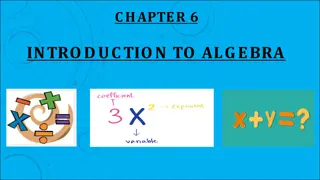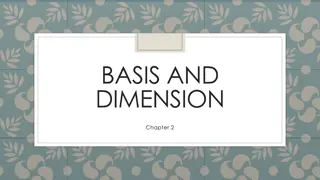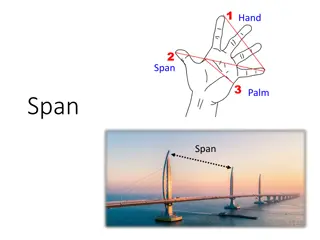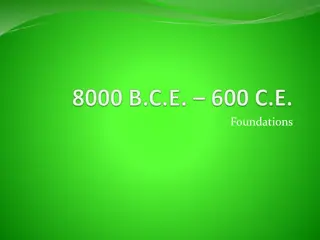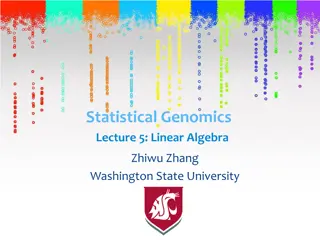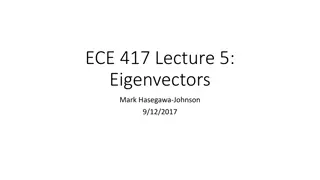The Oldest Applications of Linear Algebra in Ancient Civilizations
Linear algebra has roots in ancient civilizations like Egypt, where mathematical problems related to land measurement, resource distribution, and taxation were solved using techniques like Gaussian elimination and Cramer's Rule. The Rhind Papyrus from 1650 B.C. contains examples of linear systems and arithmetic progressions, showcasing early applications of linear algebra concepts.
Download Presentation

Please find below an Image/Link to download the presentation.
The content on the website is provided AS IS for your information and personal use only. It may not be sold, licensed, or shared on other websites without obtaining consent from the author.If you encounter any issues during the download, it is possible that the publisher has removed the file from their server.
You are allowed to download the files provided on this website for personal or commercial use, subject to the condition that they are used lawfully. All files are the property of their respective owners.
The content on the website is provided AS IS for your information and personal use only. It may not be sold, licensed, or shared on other websites without obtaining consent from the author.
E N D
Presentation Transcript
11.4: The Earliest Applications of Linear Algebra By: Sid & Zoheb
History of Linear Algebra Emerged from the study of determinants, Leibniz Gabriel Cramer: Cramer s Rule Gauss: Gaussian elimination All were used to solve linear systems
Ancient Civilizations & Linear Systems Linear systems can be found in the earliest writings of many ancient civilizations Practical problems of early civilizations included the measurement of land, distribution of goods, tracks of resources, and taxation Predate the Islamic mathematicians who created the field of algebra, which eventually led to the branch of linear algebra
Egyptian Math 1650 B.C Ahmes (Rhind) Papyrus -5 meters long -84 short mathematical problems + solutions -Hieratic -geometry, notation, mensuration, algebra, arithmetic
Problem 40 Divide 100 hekats (Ancient Egyptian volume unit, equivalent to 4.8 liters today) of barley among 5 men in arithmetic progression so that the sum of the smallest is one-seventh the sum of the three largest.
Solution to Problem 40(Egyptian Style) Step 1: Define Variables. a=least amount that any man obtains, d=common difference of the terms Step 2: set-up equations - a+(a+d)+(a+2d)+(a+3d)+(a+4d)=100 - (1/7)((a+2d)+(a+3d)+(a+4d))=a+(a+d) - 5a+10d=100 - 11a-2d=0
Methods to solve for a and d Graph Substitution Elimination Gauss-Jordan Multiply inverse of A by the answer matrix Cramer s Rule False position/assumption(The Egyptian Way)
False Position/Assumption Method 5a + 10d=100 11a-2d=0 Step 1: Assume a convenient value of a:(a=1) Step 2: substitute the value of a to second equation. (d=11/2) Step 3: insert a and d values to first equation(you get 60 which is not equal to 100) Step 4: 100/60 *1(assumed a)=5/3=a(real a)
False Position/Assumption Method cont. Step 5: substitute a=5/3 into second equation. d=55/6 Answer: the quantities of barley by the five men are : 10/6, 65/6, 120/6,175/6,230/6
Greek Linear Systems 3rdcentury B.C Most famous problem: Archimedes celebrated Cattle problem - Challenge for Eratosthenes by Archimedes. - No solution from ancient times, not known how the greeks solved it
Cattle Problem If thou art diligent and wise, O stranger, compute the number of cattle of the Sun, who once upon a time grazed on the fields of the Thrinacian isle of Sicily, divided into four herds of different colours, one milk white, another a glossy black, a third yellow and the last dappled. In each herd were bulls, mighty in number according to these proportions: Understand, stranger, that the white bulls were equal to a half and a third of the black together with the whole of the yellow, while the black were equal to the fourth part of the dappled and a fifth, together with, once more, the whole of the yellow. Observe further that the remaining bulls, the dappled, were equal to a sixth part of the white and a seventh, together with all of the yellow. These were the proportions of the cows: The white were precisely equal to the third part and a fourth of the whole herd of the black; while the black were equal to the fourth part once more of the dappled and with it a fifth part, when all, including the bulls, went to pasture together. Now the dappled in four parts were equal in number to a fifth part and a sixth of the yellow herd. Finally the yellow were in number equal to a sixth part and a seventh of the white herd. If thou canst accurately tell, O stranger, the number of cattle of the Sun, giving separately the number of well-fed bulls and again the number of females according to each colour, thou wouldst not be called unskilled or ignorant of numbers, but not yet shalt thou be numbered among the wise.
Variables for Cattle Problem W=number of white bulls B=number of black bulls Y=number of yellow bulls D=number of dappled bulls w= number of white cows b=number of black cows y=number of yellow cows d=number of dappled cows
Equations The white bulls were equal to a half and a third of the black bulls together with the whole of the yellow bulls W=(.5+1/3)B+Y The black bulls were equal to the fourth part of the dappled bulls and a fifth, together with, once more, the whole of the yellow bulls B(.25+.2)D+Y
Equations Cont. The remaining bulls, the dappled, were equal to a sixth part of the white bulls and a seventh, together with all of the yellow bulls. D=(1/6+1/7)W+Y The white cows were precisely equal to the third part and a fourth of the whole herd of the black w=(1/3+1/4)(B+b)
Equations Cont. The black cows were equal to the fourth parth once more of the dappled and with it a 5th part when all including the bulls, went to pasture together b=(1/4+1/5)(D+d) The dappled cows in four parts were equal in number to a fifth part and a sixth of the yellow herd d=(1/5+1/6)(Y+y)
Equations Cont. The yellow cows were in number equal to a sixth part and a seventh of the white herd Y=(1/6 + 1/7)(W+w)
After some math W=10,366,482k B=7,460,514k Y=4,149,387k D=7,358,060k w=7,206,360k b=4,893,246k y=5439213k d=3,515,820k
Indian Math Fourth century A.D Bakhsali Manuscript -70 leaves or sheets of birch bark -mathematical problems and solutions -equalization problems that leads to systems of linear equations
Indian Problem Once merchant has seven asava horses, a second has 9 haya horses, and a third has then camels. They are equally well off in the value of their animals if each gives two animals, one to each of the others. Find the price of each animals possessed by each merchant
Variables & Equations x=price of an asava horse y=price of a haya horse z= price of a camel K= total value of animals 5x +y +z=K x + 7y +z=K x + y +8z= K
Solution Method subtract (x+y+z) from both sides of each equation 4x=6y=7z=K-(x+y+z) K-(x+y+z) must be an integer that is divisible by 4,6,7. so it equals 4*6*7=168 Plugging it into the equation above. x=42, y=28, z=24
Chinese Problems There are three classes of corn, of which three bundles of the first class, two of the second, and one of the third make 39. Two of the first, three of the second and one of the third make 34. And one of the first, two of the second, and three of the third make 26. How many measures of corn are contained in one bundle of each class?
Game #1 A passenger jet took three hours to fly 1800 miles in the direction of the jetstream. The return trip against the jetstream took four hours. What was the jet's speed in still air and the jetstream's speed?
Problem 63 of the Ahmes 700 loaves are to be divided among recipients in the following proportions: 2/3; ;1/3;1/4 How much does each person receive?
Problem 24 Find the heep if the heap and a seventh of the heep is 19. Use False position
Berlin Papyrus #1 You are told the area of a square of 100 square cubits is equal to that of two smaller squares, the side of one square is 1/2 + 1/4 of the other. What are the sides of the two unknown squares.







